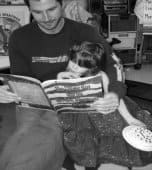Learn how you can help close the literacy gap and make a difference in the lives of those in need. Get involved today and help make a difference
Growing up in a society that has abundant access to education, we generally believe that we all benefit equally from the educational system. With most of us being from the middle class, we enter school and come out with almost similar skills that help us proceed in life. As students, we don’t pay much attention to our peers who struggle or drop out. Later in life, we often do not realize the quantity of individuals that were left behind in the education system. It is likely that our daily routines and social circles isolate us from this population. Regardless, we believe that as members of a developed nation, we have all obtained proper literacy skills.
But outside of our understanding of social and economic realities, there is a heartbreaking issue affecting many Canadians. A significant portion, often hailing from financially struggling backgrounds, are facing the challenges of illiteracy. This issue is seen across Canada, from distant First Nations communities to our bustling cities. Kids from impoverished families are entering school without the critical skills to succeed in their education. Over one million kids from low-income families start school with limited vocabulary, literacy, and social skills compared to middle-class peers. Often, this gap remains, preventing the children from catching up. Consequently, they fail, drop out, or leave school early.

It might be surprising to those unfamiliar with the issue, but about 15% of adult Canadians are currently functioning at the lowest literacy levels. In fact, more than twice that number have not reached literacy levels necessary for proper life advancement. These numbers originate from a country widely regarded as having high standards of living.
Unfortunately, there is currently no easy solution to this situation. Poverty is not easy to get rid of in even the most fortunate societies. However, there is some good news. According to literary experts, there is another way to help kids avoid illiteracy besides the difficult task of ending poverty. Providing access to high quality books during early childhood can help. Lack of reading materials is a significant cause of illiteracy in children. Most poor families and Canadian literacy programs helping these children both face a scarcity of high-quality books. It’s rare for low-income families to own books.
In response to this crisis, a handful of individuals came together in 2004 to establish the Institute of Cross-cultural Exchange (ICE) – an all-volunteer charity organization dedicated to promoting children’s literacy and cross-cultural education at home and abroad. ICE raises money and acquires funding to purchase and donate children’s books to literacy programs; and at the same time, through its choice of titles, encourages learning about other cultures and understanding between them.
ICE currently donates a number of children’s titles published by Hoopoe Books, a non-profit publisher in the United States. The books contain beautifully illustrated folk tales from the Middle East and Central Asia that were collected and written into English by the late Afghan author, Idries Shah. Originating in the storytelling traditions of the East, the books are uniquely effective in the development of reading, language and thinking skills. The stories are designed to activate contextual thinking skills associated with the right side of the brain and help children manage a range of issues: including how to deal with fear, overcome difficulties, build self-confidence, find peaceful solutions, and work towards goals and dreams.

In just eight years ICE has donated over 82,000 books to more than 80 non-profit literacy groups in Canada. ICE has also provided tens of thousands more titles overseas for children who are in similar circumstances. In 2010, it started distributing Dari-Pashto editions to schools, orphan-ages and NGOs (Non-Governmental Organizations) in Afghanistan. Hundreds of Spanish-English bilingual editions have also been delivered to children in Mexico, via a partner organization there. For most of the children, our books were the first they ever owned.
The books have been incredibly well-received by educators and families. As word spreads about the books, demand for the titles is increasing, both domestically and abroad. The goal of ICE is to increase its book donations to meet that growing need and to help close the literacy gap, which has proven so damaging to individuals and societies.
Pension Financial Literacy Gap in Canada
In Canada, a significant financial literacy gap exists when it comes to pension planning. Many Canadians lack the necessary knowledge and understanding to make informed decisions about their retirement savings. This gap in financial literacy can have serious consequences for retirees who may find themselves without enough money to support themselves in their golden years.
Understanding the Pension Financial Literacy Gap
The pension financial literacy gap refers to the difference between what Canadians know about pensions and what they need to know to make informed decisions. Many Canadians are unaware of the different types of pensions available, how they work, and the benefits and drawbacks of each. They may not understand how much they need to save, how to invest their savings, or how to withdraw money from their pension plan.
This lack of understanding can have serious consequences. For example, Canadians may not contribute enough to their pension plan, invest their savings poorly, or withdraw their funds too early or too late. All of these mistakes can result in a lower retirement income than expected, leaving retirees struggling to make ends meet.
Why the Pension Financial Literacy Gap Exists
There are many reasons why Canadians struggle with financial literacy when it comes to pensions. The pension system in Canada is complex and ever-changing with a variety of options, making it tough for them to make informed choices.
Additionally, most Canadians do not receive adequate education on pensions. Schools don’t teach much about managing money and retirement, and many employers don’t provide the necessary education or resources to help employees make informed decisions about their retirement savings.
On top of that, the pension industry can be confusing and difficult to understand. Many pension plans are full of jargon and technical terms that can intimidate those who don’t know them.
The Consequences of the Pension Financial Literacy Gap
The consequences of the pension financial literacy gap can be severe. Without a solid understanding of pensions, Canadians may not contribute enough to their pension plan, invest their savings poorly, or withdraw their funds too early or too late. All of these mistakes can result in a lower retirement income than expected, leaving retirees struggling to make ends meet.
In addition, retirees who do not have enough money to support themselves may have to rely on government programs, such as the Canada Pension Plan and Old Age Security. While these government programs are designed to provide a basic level of support for seniors, they may not be enough to cover all expenses in retirement. This can lead to financial insecurity and a reduced standard of living for retirees.
Moreover, the pension financial literacy gap can have broader economic consequences. If a large number of Canadians are not adequately prepared for retirement, it could put a strain on the government’s social safety net programs, as well as on the overall economy. Retirees who do not have sufficient retirement savings may be forced to continue working longer than they would like, potentially reducing job opportunities for younger workers.
Additionally, retirees with insufficient retirement savings may have to rely on family members for support, which could place a burden on the younger generation. This, in turn, could impact their ability to save for their own retirement, perpetuating the cycle of financial insecurity and lack of pension literacy.
To address the pension financial literacy gap, governments, employers, and financial institutions must work together to provide education and resources to Canadians. This includes providing clear and concise information about pension plans, retirement savings options, and investment strategies. Employers can also play a role by offering retirement planning services and financial education programs to their employees.
Ultimately, closing the pension financial literacy gap is crucial to ensuring that Canadians are able to retire comfortably and with financial security. By providing the necessary education and resources, we can help individuals make informed decisions about their retirement savings and investments, and reduce the economic burden on future generations.

